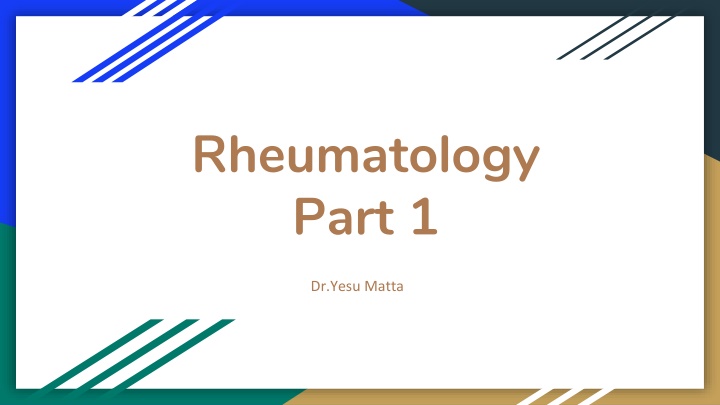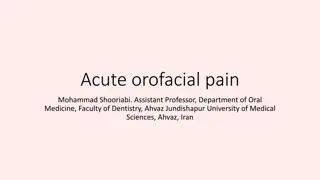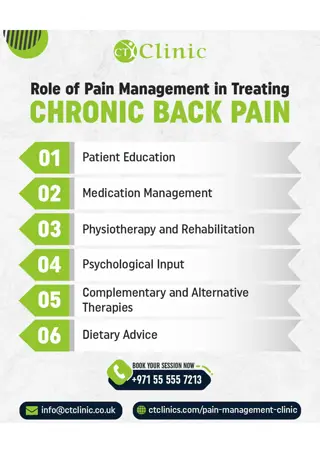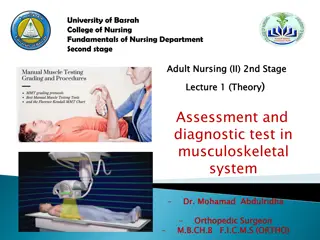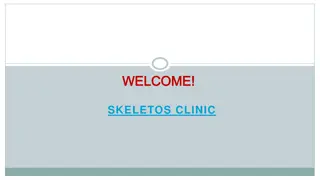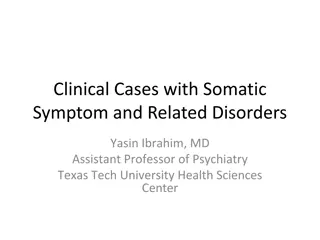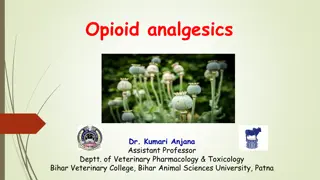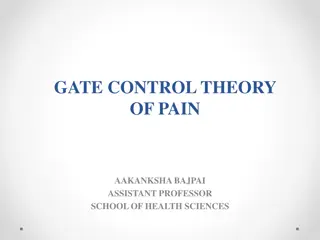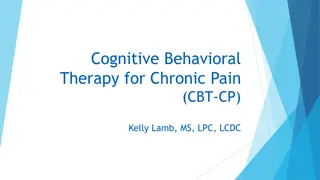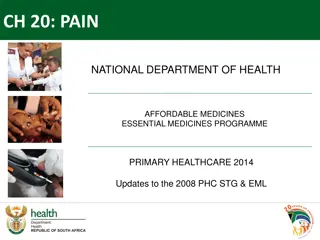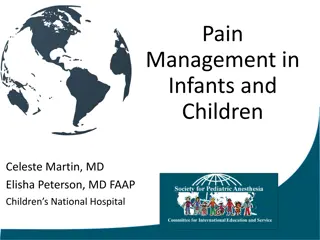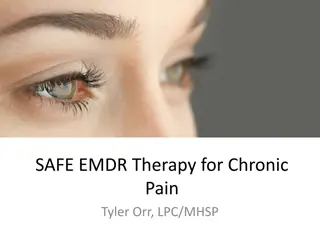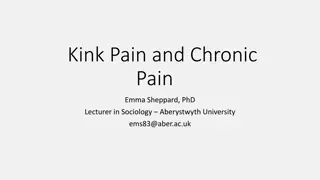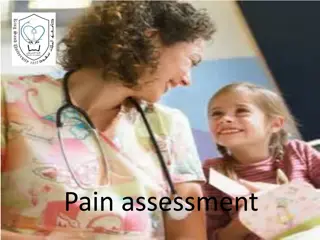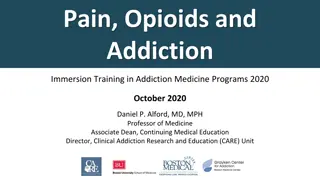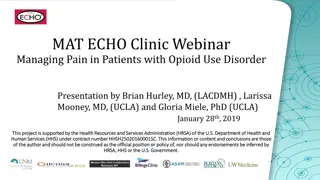Chronic Musculoskeletal Pain in Children
Chronic musculoskeletal pain in children can present as growing pains, often starting between ages 3 to 12 years. Pain is typically bilateral, located in the lower extremities, and can be severe, affecting sleep but usually resolving by morning. It is essential to differentiate benign growing pains from other pathological conditions to provide appropriate reassurance and management for the child and their parents.
Download Presentation

Please find below an Image/Link to download the presentation.
The content on the website is provided AS IS for your information and personal use only. It may not be sold, licensed, or shared on other websites without obtaining consent from the author.If you encounter any issues during the download, it is possible that the publisher has removed the file from their server.
You are allowed to download the files provided on this website for personal or commercial use, subject to the condition that they are used lawfully. All files are the property of their respective owners.
The content on the website is provided AS IS for your information and personal use only. It may not be sold, licensed, or shared on other websites without obtaining consent from the author.
E N D
Presentation Transcript
Rheumatology Part 1 Dr.Yesu Matta
Common Serum Rheumatologic Tests Rheumatoid Factor Antinuclear Antibody Chromatin-Associated Antibodies ANTI DOUBLE-STRANDED DNA ANTI-HISTONE Ribonucleoproteins ANTI SMALL NUCLEAR RIBONUCLEOPROTEINS ANTI-RO AND ANTI-LA ANTI-RIBOSOME
Scleroderma Antibodies ANTI-CENTROMERE ANTI-TOPOISOMERASE I Other Antibody Tests ANTI-JO1 ANTINEUTROPHIL CYTOPLASMIC ANTIBODIES Human Leukocyte Antigen B27
Growing pains(Benign nocturnal limb pains of childhood ) Are cramping pains of the thigh, shin, and calf. The exact pathophysiology of the pain is unknown: it is not associated with the pubertal growth spurt but theoretically may be associated with growth in general. Physical examination of the child is normal. No further diagnostic testing is necessary in the absence of worrisome complaints or anatomic abnormalities. Parents should be reassured that there are no long-term sequelae.
Growing pains usually begin between ages 3 to 12 years. CLINICAL FEATURES Pain occurs primarily in the lower extremities. Upper-extremity pain can occur in conjunction with lower-extremity pain. Pain is often bilateral and located deep in the legs, usually the thigh, calf, popliteal fossa, or shin. Pain is paroxysmal and may be severe. In older children (6 to 12 years), the pain may be described as crampy, a creeping sensation, or restless legs. Pain occurs primarily in the evening or nighttime hours and may interrupt sleep. It usually resolves by morning, but some patients have isolated daytime complaints. Daytime complaints rarely limit usual activities.
Pain is relieved by massage, heat, or first-order analgesics, such as acetaminophen or ibuprofen. Normal patterns of activity are maintained. The physical examination during and after the episodes is normal. Associated complaints of recurrent abdominal pain and/or headaches occur in approximately one-third of patients. A family history of growing pains or rheumatic complaints is common. The pains are chronic but episodic, typically occurring at least once a week, with an overall duration that often may last years and persist into adolescence. However, symptom-free periods of days, weeks, or months may occur between episodes.
Benign hypermobility syndrome Occurs typically in young girls before or during adolescence. Patients with this condition present with musculoskeletal pain associated with generalized hypermobility of joints but no associated congenital syndrome Connective tissue diseases such as Marfan syndrome and Ehlers-Danlos syndrome should be considered The diagnosis of JHS is made clinically, based upon the medical history and physical examination, using the Brighton 1998 criteria for JHS which includes use of the Beighton hypermobility score . 4 or more is positive ( 1 for each side)
Beighton score for joint hypermobility Passively dorsiflex the 5th metacarpophalangeal joint by at least 90 degrees Oppose the thumb to the volar aspect of the ipsilateral forearm Hyperextend the elbow by at least 10 degrees Hyperextend the knee by at least 10 degrees Place the hands flat on the floor without bending the knees
Rheumatic fever: Rheumatic fever is a late inflammatory complication of acute group A streptococcal pharyngitis that manifests as an acute systemic febrile illness; it can include migratory arthritis involving the large joints, signs and symptoms of carditis and valvulitis, the erythema marginatum rash, subcutaneous nodules and choreoathetotic movements of Sydenham s chorea.
Major: Carditis Chorea Erythema marginatum Polyarthritis Subcutaneous nodules Minor: Polyarthralgia Elevated erythrocyte sedimentation rate (> 60 mm/hour) or C-reactive protein (> 30 mg/L [> 285.7 nmol/L]) Fever ( 38.5 C) Prolonged PR interval (on ECG) Diagnosis of acute rheumatic fever requires 2 major or 1 major and 2 minor manifestations and evidence of group A streptococcal infection (elevated or rising antistreptococcal antibody titer [eg, antistreptolysin O, anti-DNase B], positive throat culture, or positive rapid antigen test in a child with clinical manifestations suggestive of streptococcal pharyngitis).
Diagnosis: Modified Jones criteria (for initial diagnosis) Testing for GAS (culture, rapid strep test, or antistreptolysin O and anti-DNase B titers) ECG Echocardiography with Doppler Erythrocyte sedimentation rate (ESR) and C-reactive protein (CRP) level
In acute rheumatic fever, the most common cardiac manifestations are Mitral regurgitation Pericarditis Sometimes aortic regurgitation
In chronic rheumatic heart disease, the most common cardiac manifestations are Mitral stenosis Aortic regurgitation (often with some degree of stenosis) Perhaps tricuspid regurgitation (often along with mitral stenosis)
Poststreptococcal Reactive Arthritis Development of arthritis after group A streptococcal infection in patients who do not meet the criteria for acute rheumatic fever. Compared with the arthritis of ARF, poststreptococcal reactive arthritis typically involves only 1 or 2 joints, is less migratory but more protracted, and does not respond as well or as quickly to aspirin. Other, nonrheumatic disorders causing similar symptoms (eg, Lyme arthritis, juvenile idiopathic arthritis) should be excluded. It can be treated with other nonsteroidal anti-inflammatory drugs (NSAIDs) such as ibuprofen and naproxen.
Vasculitis Vasculitis can be a primary disorder or secondary to other causes. Vasculitis tends to affect small-, medium-, or large-sized vessels, each with certain patterns of organ involvement. Clinical manifestations can be systemic and/or organ-specific, depending on how vessels are affected.
Small-vessel vasculitis, caused by immune complex , presents with purpura and includes drug reactions, serum sickness, and Henoch- Sch nlein purpura (HSP) as examples. Medium-vessel vasculitis causes organ system damage and includes polyarteritis nodosa (PAN) and Kawasaki disease. Large-vessel vasculitis may cause claudication symptoms; Takayasu's arteritis is the classic form of a large vessel disorder.
Immunoglobulin AAssociated Vasculitis (IgAV) (Henoch-Sch nlein Purpura) vasculitis that affects primarily small vessels. It occurs most often in children. Common manifestations include palpable purpura, arthralgias, gastrointestinal (GI) symptoms and signs, and glomerulonephritis.
Diagnosis is clinical in children but usually warrants biopsy in adults. Disease is usually self-limited in children and chronic in adults. Corticosteroids can relieve arthralgias and GI symptoms but do not alter the course of the disease. Progressive glomerulonephritis may require high-dose corticosteroids and cyclophospahmide.
Kawasaki disease Kawasaki disease is a vasculitis, sometimes involving the coronary arteries, that tends to occur in infants and children between the ages of 1 year and 8 years. It is characterized by prolonged fever, exanthem, conjunctivitis, mucous membrane inflammation, and lymphadenopathy. Coronary artery aneurysms may develop and rupture or cause myocardial infarction. Diagnosis is by clinical criteria; once the disease is diagnosed, echocardiography is done. Treatment is aspirin and IV immune globulin. Coronary thrombosis may require fibrinolysis or percutaneous interventions.
Atypical" Kawasaki disease There is a syndrome known as "atypical" Kawasaki disease, which you see in those patients who have fewer than the required 4 of 5 clinical findings needed for diagnosis. Usually missing is the cervical lymphadenopathy and rash. It more commonly occurs in younger patients, especially those under 1 year.
Behet Disease Beh et disease is a multisystem, relapsing, chronic vasculitic disorder with mucosal inflammation. Common manifestations include recurrent oral ulcers, ocular inflammation, genital ulcers, and skin lesions. The most serious manifestations are blindness, neurologic or gastrointestinal manifestations, venous thromboses, and arterial aneurysms. Diagnosis is clinical, using international criteria. Treatment is mainly symptomatic but may involve corticosteroids with or without other immunosuppressants for more severe manifestations.
International criteria for diagnosis include recurrent oral ulcers (3 times in 1 year) and 2 of the following: Recurrent genital ulcers Eye lesions Skin lesions Positive pathergy test with no other clinical explanation A positive pathergy test consists of the appearance of an erythematous induration with a sterile pustule in the skin 24 to 48 hours after the insertion of a sterile needle into the skin of the forearm.
Juvenile idiopathic arthritis (JIA) Juvenile idiopathic arthritis (JIA) is defined as occurring before the age of 16 years with persistent synovitis in one or more joints for at least 6 weeks (3 months is what many prefer) with all other diagnoses excluded. Arthritis, fever, rash, adenopathy, splenomegaly, and iridocyclitis are typical of some forms. The cause of JIA is unknown, but there seems to be a genetic predisposition as well as autoimmune and autoinflammatory pathophysiology.
JIA TYPES 1) Systemic JIA 2) Oligoarthritis: 2 subcategories a) Persistent oligoarthritis (affecting 4 or fewer joints for the duration of the disease) b) Extended arthritis (5 or more joints are affected after the first 6 months of disease) 3) Polyarthritis - rheumatoid factor-negative 4) Polyarthritis-rheumatoid factor-positive 5) Psoriatic arthritis 6) Enthesitis-related arthritis 7) Undifferentiated arthritis
Clues for diagnosis of JIA: Morning stiffness that improves with movement later in the morning. Changes in walking, running, climbing, or willingness to play, especially in the morning hours. Leg length discrepancies. Return of need for assistance with dressing, eating, bathing, and toileting. Enuresis may recur. Developmental milestones may be lost.
Symptoms and signs : Manifestations involve the joints and sometimes the eyes and/or skin; systemic juvenile idiopathic arthritis may affect multiple organs. Children typically have joint stiffness, swelling, effusion, pain, and tenderness, but some children have no pain. Joint manifestations may be symmetric or asymmetric, and involve large and/or small joints. Enthesitis typically causes tenderness of the iliac crest and spine, greater trochanter of the femur, patella, tibial tuberosity, Achilles insertion, or plantar fascia insertions. Sometimes, JIA interferes with growth and development. Micrognathia (receded chin) due to early closure of mandibular epiphyses or limb length inequality (usually the affected limb is longer) may occur.
The most common comorbidity is iridocyclitis . Iridocyclitis is most common in oligoarticular JIA, developing in nearly 20% of patients, especially if patients are positive for antinuclear antibodies (ANA). Skin abnormalities are present mainly in psoriatic JIA, in which psoriatic skin lesions, dactylitis, and/or nail pits may be present, and in systemic JIA, in which a typical transient rash often appears with fever. Rash in systemic JIA may be diffuse and migratory, with urticarial or macular lesions with central clearing. Systemic abnormalities in systemic JIA include high fever, rash, splenomegaly, generalized adenopathy (especially of the axillary nodes), serositis with pericarditis or pleuritis, and lung disease. These symptoms may precede the development of arthritis. Fever occurs daily (quotidian) and is often highest in the afternoon or evening and may recur for weeks. In 7 to 10% of patients, systemic JIA may be complicated by macrophage activation syndrome, a life- threatening cytokine storm syndrome.
DIagnosis of JIA: Clinical evaluation Rheumatoid factor (RF), antinuclear antibodies (ANA), anticyclic citrullinated peptide (anti- CCP) antibodies, and HLA-B27 tests Juvenile idiopathic arthritis should be suspected in children with symptoms of arthritis, signs of iridocyclitis, generalized adenopathy, splenomegaly, or unexplained rash or prolonged fever, especially if quotidian. Diagnosis of JIA is primarily clinical. It is made when a chronic noninfectious arthritis lasting > 6 weeks has no other known cause. Patients with JIA should be tested for RF, anti-CCP antibodies, ANA, and HLA-B27 because these tests may be helpful in distinguishing between forms. The test for ANA should be done by immunofluorescence because other methods may result in false-negative results.
In systemic JIA, RF and ANA are usually absent. In oligoarticular JIA, ANA are present in up to 75% of patients and RF is usually absent. In polyarticular JIA, RF usually is negative, but in some patients, mostly adolescent girls, it can be positive. HLA-B27 is present more commonly in enthesitis-related arthritis. In systemic JIA, laboratory abnormalities suggestive of systemic inflammation, such as elevated erythrocyte sedimentation rate (ESR), ferritin, and C-reactive protein, along with leukocytosis, anemia, and thrombocytosis are almost always present at diagnosis. To diagnose iridocyclitis, a slit-lamp examination should be done even in the absence of ocular symptoms. A recently diagnosed patient with oligoarticular or polyarticular JIA should have an eye examination every 3 months if ANA test results are positive and every 6 months if ANA test results are negative.
Prognosis: Remissions occur in 50 to 70% of treated patients. Patients with RF- positive polyarticular JIA have a less favorable prognosis.
Treatment: Drugs that slow disease progression (particularly methotrexate, tumor necrosis factor [TNF] inhibitors, and interleukin [IL]-1 inhibitors) Intra-articular corticosteroid injections Sometimes nonsteroidal anti-inflammatory drugs (NSAIDs) for symptom relief
Reactive Arthritis Reactive arthritis is conventionally defined as an arthritis that arises following an infection, although the pathogens cannot be cultured from the affected joints. It is generally regarded as a form of spondyloarthritis Spondyloarthropathy associated with urethritis or cervicitis, conjunctivitis, and mucocutaneous lesions (previously called Reiter syndrome) is one type of reactive arthritis.
Etiology: Two forms of reactive arthritis are common: sexually transmitted and dysenteric. The sexually transmitted form occurs primarily in men aged 20 to 40. Genital infections with Chlamydia trachomatis are most often implicated. Men or women can acquire the dysenteric form after enteric infections, primarily Shigella, Salmonella, Yersinia, or Campylobacter. Reactive arthritis probably results from joint infection or postinfectious inflammation. Although there is evidence of microbial antigens in the synovium, organisms cannot be cultured from joint fluid.
Epidemiology: The prevalence of the human leukocyte antigen B27 (HLA-B27) allele in patients is 63 to 96% versus 6 to 15% in healthy white controls, thus supporting a genetic predisposition.
Symptoms and signs: Reactive arthritis can range from transient monarticular arthritis to a severe, multisystem disorder. Constitutional symptoms may include fever, fatigue, and weight loss. Arthritis may be mild or severe. Joint involvement is generally asymmetric and oligoarticular or polyarticular, occurring predominantly in the large joints of the lower extremities and in the toes. Back pain may occur, usually with severe disease.
Enthesopathy (inflammation at tendinous insertion into boneeg, plantar fasciitis, digital periostitis, Achilles tendinitis) is common and characteristic. Mucocutaneous lesions small, transient, relatively painless, superficial ulcers commonly occur on the oral mucosa, tongue, and glans penis (balanitis circinata). Particularly characteristic are vesicles (sometimes identical to pustular psoriasis) of the palms and soles and around the nails that become hyperkeratotic and form crusts (keratoderma blennorrhagicum). Keratoderma blennorrhagicum can also include erythema, plaques, and scaling. Rarely, cardiovascular complications (eg, aortitis, aortic insufficiency, cardiac conduction defects), pleuritis, and central nervous system or peripheral nervous system symptoms develop.
Treatment: Treat with NSAIDs. In more severe cases, you may need to use antibiotic therapy, such as doxycycline, in children over 7 years of age. Resistant cases may require sulfasalazine, methotrexate, and/or anti-TNF agents.
Childhood and Adolescent Sports-Related Overuse Injuries: Children and adolescents may be particularly at risk for sports-related overuse injuries as a result of improper technique, poorly fitting protective equipment, training errors, and muscle weakness and imbalance. The apophysis is a secondary center of ossification and a location for the insertion of a muscle tendon into bone. Overuse syndromes such as traction apophysitis may develop in young athletes when this growth center is unable to meet the demands placed on it during activity. Some sites of apophyseal injury include the knee (Osgood-Schlatter disease), heel (Sever s disease), and medial epicondyle (little leaguer s elbow).
Overuse injuries can be classified into four categories: (1) pain in the affected area after physical activity (2) pain that occurs during the activity but does not restrict performance (3) pain that occurs during the activity and restricts performance (4) chronic, unremitting pain, even at rest. Athletes, their families, and their coaches should be counseled to recognize early symptoms of overuse injuries.
Little leaguers shoulder, a stress fracture of the proximal humerus that presents as lateral shoulder pain, usually is self-limited. Little leaguer s elbow is a medial stress injury Spondylolysis is a stress fracture of the pars interarticularis. Spondylolisthesis is the forward or anterior displacement of one vertebral body over another and may be related to a history of spondylolysis. Osgood-Schlatter disease presents as anterior knee pain localized to the tibial tubercle. Calcaneal apophysitis (or Sever s disease) is a common cause of heel pain in young athletes, presenting as pain in the posterior aspect of the calcaneus.
